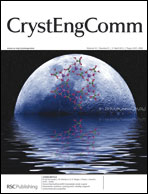Controlled synthesis of three-dimensional CoNi microstructures composed of single crystal CoNi nanoleaves†
Abstract
Three dimensional (3D) alloyed micro- and nanostructures composed of nanoscale subunits with regular and novel morphologies have received intensive attention due to their interesting physicochemical properties and wide applications in different areas. In this study, 3D CoNi microstructures consisting of well-defined CoNi nanoleaves are synthesized by a complexant-assisted wet-chemical reduction process free of any surfactant or template, which is suitable for large scale production. Elemental maps obtained by X-ray energy-dispersive spectroscopy (EDS) indicate that Co and Ni elements are homogenously distributed in the microstructures, verifying that the sample is an alloy rather than a mixture of Co and Ni. High resolution transmission electron microscopy (HRTEM) images and the selected area electron diffraction (SAED) pattern demonstrate the nanoleaves in the 3D microstructures are single crystals. Magnetic measurements at room temperature revealed that the as-prepared 3D CoNi microstructures exhibit a ferromagnetic property with a coercivity of 197.4 Oe, which is much higher than that of many CoNi micro- and nanostructures reported in recent literature. Based on the evolution of the morphology of the products with increasing reaction time, a possible formation mechanism is proposed to illustrate the growth of the CoNi microstructures.


 Please wait while we load your content...
Please wait while we load your content...